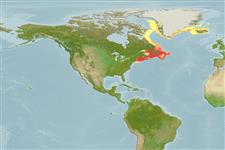Environment: milieu / climate zone / depth range / distribution range
Ecologia
marino demersale; distribuzione batimetrica 70 - 592 m (Ref. 5951), usually 128 - 366 m (Ref. 5951). Temperate; 74°N - 35°N, 75°W - 13°W
Northwest Atlantic: Gulf of St. Lawrence to shelf waters of Nova Scotia in Canada. Northeast Atlantic: off Iceland and western Greenland (Ref. 4570).
Length at first maturity / Size / Peso / Age
Maturity: Lm 22.3 range ? - ? cm
Max length : 47.0 cm TL maschio/sesso non determinato; (Ref. 49746)
Inhabits shallow water; rocky or clay-silt bottom (Ref. 5951). Bears live young. Gregarious during all life. Feeds on euphausiids, decapods, mysids, small mollusks and fishes. Ovoviviparous (Ref. 4570). A long-lived species with estimated life span of 30-50 years, slow growing and has low fecundity. Late juveniles (11-20 cm total length) were primarily associated with boulder reefs that have deep interstices amongst the boulders; as well as in exposed boulders that do not have crevices along their lower margins, but are surrounded by dense patches of cerianthid anemones, Cerianthus borealis. The use of both boulder and cerianthid habitats are either on an encounter basis, regardless of habitat saturation or predation pressure, or because boulder reefs serve as recruitment habitats, and cerianthid habitats serve as a conduit for redfish moving away from saturated boulder reef sites (Ref. 58487).
Life cycle and mating behavior
Maturità | Riproduzione | Deposizione | Uova | Fecundity | Larve
Ovoviviparous (Ref. 4570).
Robins, C.R. and G.C. Ray, 1986. A field guide to Atlantic coast fishes of North America. Houghton Mifflin Company, Boston, U.S.A. 354 p. (Ref. 7251)
IUCN Red List Status (Ref. 130435)
Threat to humans
Harmless
Human uses
Informazioni ulteriori
BibliografiaAcquacolturaProfilo di acquacolturaVarietàGeneticaElectrophoresesEreditarietàMalattieElaborazioneNutrientsMass conversion
CollaboratoriImmaginiStamps, Coins Misc.SuoniCiguateraVelocitàModalità di nuotoArea branchialeOtolithsCervelliVista
Strumenti
Special reports
Download XML
Fonti Internet
Estimates based on models
Preferred temperature (Ref.
123201): 0.8 - 7.8, mean 5.2 °C (based on 147 cells).
Phylogenetic diversity index (Ref.
82804): PD
50 = 0.5000 [Uniqueness, from 0.5 = low to 2.0 = high].
Bayesian length-weight: a=0.01023 (0.00675 - 0.01551), b=3.13 (3.01 - 3.25), in cm total length, based on LWR estimates for this species & Genus-body shape (Ref.
93245).
Trophic level (Ref.
69278): 3.2 ±0.2 se; based on diet studies.
Resilienza (Ref.
120179): Basso, tempo minimo di raddoppiamento della popolazione 4.5 - 14 anni (tm=5.5).
Fishing Vulnerability (Ref.
59153): Moderate to high vulnerability (49 of 100).
Nutrients (Ref.
124155): Calcium = 31.1 [11.9, 105.5] mg/100g; Iron = 0.275 [0.114, 0.699] mg/100g; Protein = 17.6 [16.4, 18.8] %; Omega3 = 1.34 [0.56, 3.30] g/100g; Selenium = 39.4 [14.5, 112.6] μg/100g; VitaminA = 28.4 [8.6, 92.1] μg/100g; Zinc = 0.469 [0.244, 0.840] mg/100g (wet weight);
